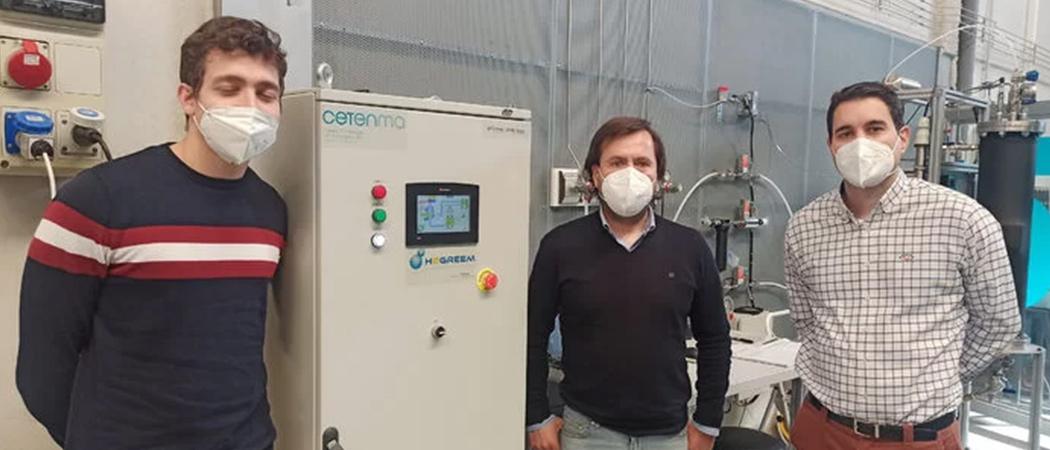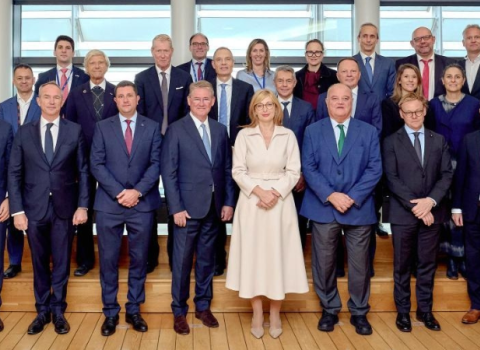The Startup Village initiative is struggling to demonstrate the Commission’s vision of deep tech companies energising the rural economy

H2Greem delivers an electrolyzer in Cetenma, Spain.
The Commission has high hopes for Startup Villages, an instrument intended to bolster innovation in rural areas. Yet the scheme has developed in a haphazard way, its first ‘winners’ determined by the private companies willing to pledge sponsorship. The first to commit, and the most generous, was Chinese tech giant Huawei.
Of the 10 Startup Villages so far announced by the Commission, nine are receiving support from Huawei to run local co-working spaces. The tenth is more interesting: a village that has welcomed a ‘deep tech’ start-up making electrolysers to produce green hydrogen. And this is what the Commission has in mind for the future.
“Deep tech companies often chose rural areas to develop their ideas, because they need space and they need different conditions,” said Mariya Gabriel, EU research and innovation commissioner, in a debate with some of the winners in April. “We already have very good examples, but we need to tackle some of the concrete challenges. That means additional funding, access to networking, access to capital, access to talent.”
The present Startup Village initiative has its roots in the Commission’s long-term vision for the EU’s rural areas, adopted in June 2021. This included a flagship action on research and innovation for rural communities, part of which was the establishment of a Startup Village Forum, to promote knowledge exchange and cooperation for innovation driven by start-ups in rural areas. This gave no guidance on what a Startup Village should be, nor any EU funding for their support.
Driven by pledges
By the time the forum was launched in November 2021, it had acquired a fund-raising function. Public and private organisations would be invited to pledge support for Startup Villages, either in cash or in kind. Suggestions for in-kind support included provision of co-working spaces, IT infrastructure or expertise, coaching, mentoring or training, aimed at creating start-ups and job opportunities.
Four companies stepped up, much to Gabriel’s satisfaction. “I’m pleased to see that the pledges come from large corporations as well as SMEs and start-ups, and I think that this is a good sign of the vitality and further potential of the Startup Village concept,” she said in April.
Huawei was the first to announce its pledge, and the most generous. There would be six awards of €20,000 to cover the salary of someone to run a co-working space in each Startup Village, an offer later topped up with three minor awards worth €10,000. The nine villages selected account for nine of the 10 winners announced so far by the forum.
A pledge by Spanish energy multinational Iberdrola bizarrely offered up to five winners the chance to take part in reforestation projects. No winners have been announced to date. Irish data mapping start-up Abodoo offered to create an interactive map for one Startup Village, promoting its assets in order to attract remote workers and support rural regeneration. A further 22 villages would then get a discount on the same product. Berzosa del Lozoya in central Spain won this prize, but does not appear in the list of 10 winning Startup Villages.
The final pledge came from Spanish energy giant Enagás. It proposed Hontoria near Segovia in central Spain as a Startup Village, since this is where its start-up H2Greem is manufacturing electrolysers for the production of hydrogen gas.
This ticks several boxes for the Commission. First of all, it involves an energy technology that will contribute to the Green Deal and Europe’s energy transition. Second, it is a ‘deep tech’ start-up, based on a technological rather than a digital innovation. Where digital start-ups only need server space to thrive, deep tech start-ups often need physical space for their physical factories and, the argument goes, rural areas can provide these at a competitive price.
Welcome to Hontoria
H2Greem makes proton exchange membrane (PEM) electrolysers for splitting water to its constituent hydrogen and oxygen. Given the electricity to do this comes from a renewable source, this generates green hydrogen. The proprietary catalyst technology was developed over two decades by engineer and entrepreneur Mario Carrero. After a planned buy-out of his company derailed in 2019, the venture capital arm of Enagás stepped in to bankroll a new start-up to take the technology forward. H2Greem was created in 2020, with Carrero as chief executive.
“The technology has been there for a while, it’s just a matter of the market being ready for mainstream acceptance,” said Luis Sacristan, head of business development and sales at the company. “Climate change is part of that, but then Covid, and now the war in Ukraine, are pushing things a lot faster.”
Having the backing of Enagás means that the company has not needed to look for additional venture capital support or public subsidies to set up. “In that sense, we have been lucky to have come across such a big player interested in our project,” Sacristan said.
The decision to set up H2Greem’s manufacturing in Hontoria is first and foremost because this is where Carrero started developing his previous company. It has a large industrial estate, six or seven times the size of the village itself, which blends with the urban sprawl around Segovia. It is hardly rural.
“In terms of logistics, Hontoria is very well-connected,” Sacristan said. “And in terms of manufacturing, it offers enough knowledge and manpower to do it locally. As of today, it’s a matter of having enough space and knowing how to build the electrolysers.”
The present factory extends over 1,400 square metres including offices, and the company currently has a staff of eight. “We are working on several projects, and next month we are starting a European-funded project for a 1MW electrolyser. That should result in an increase to 20-22 people,” said Sacristan.
A lab manager has been recruited from one of the universities in Madrid, but otherwise the workforce can be found locally, he said. “For the assembly you need specific training, but we are not finding difficulties in finding the right people.”
Aside from this small boost to local employment, Sacristan admits that H2Greem currently has limited impact in Hontoria. But having a national leader in hydrogen technology on the site could build into something. “As time goes by, it will put this town on the map.”
On the other hand, if H2Greem does well in the hydrogen boom, its needs are likely to change. “If we need to set up a giga-factory, which is what people are talking about for the future, we might well have to move out of Hontoria, or find more locations. But at our present stage, the industrial estate where we are now offers enough space to upsize our plant.”
Elsewhere in the Ecosystem…
- The Commission is looking for start-ups to fill an online catalogue of use cases for a more resilient industry. The initiative will highlight digital solutions and business models that promise high-impact solutions to decrease dependence on oil, gas and external raw materials, as well as increase resilience in the global supply chain. The context is the war in Ukraine, and the catalogue is open to start-ups and SMEs from the EU, Ukraine, Moldova and Georgia. Participation also opens doors to Commission-sponsored workshops and other forms of business support.
- The COVID-19 therapeutics innovation booster, promised by the Commission for July last year, was finally unveiled in May. Its goal is to develop an overview of COVID-19 therapeutics under development, in order to better support (through existing channels) the most promising projects from preclinical research to market authorisation. The suggested creation of a trans-European platform to cross-validate promising COVID 19 therapeutics is still under discussion.
- All EU initiatives in support of defence innovation and entrepreneurship are to be rolled into a single EU Defence Innovation Scheme, the Commission has announced. The aim is to apply to the defence sector practices proven in civil innovation. New initiatives to this end outlined in the European Defence Fund work programme for 2022 include a defence equity facility, which is expected to generate €500 million investment capacity, and a technological challenge for hidden-threats detection. There will also be a four-year partnership for the development of defence medical countermeasures against chemical, biological, radiological and nuclear threats.





 A unique international forum for public research organisations and companies to connect their external engagement with strategic interests around their R&D system.
A unique international forum for public research organisations and companies to connect their external engagement with strategic interests around their R&D system.